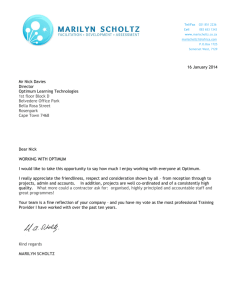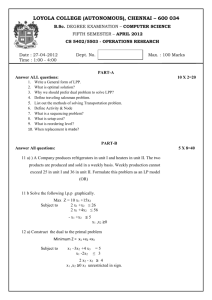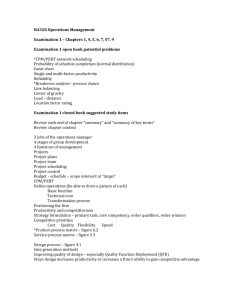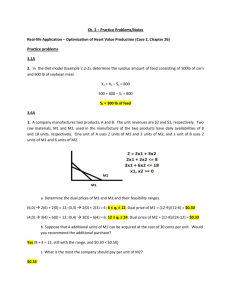Introduction to Operations Research
advertisement
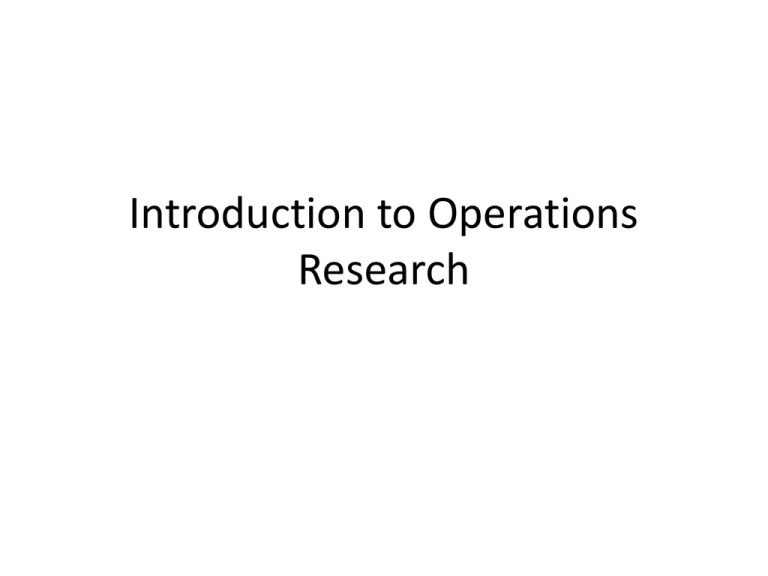
Introduction to Operations Research Introduction VIDEO A New View of Analytics and Operations Research Introduction • Operations Research (OR) is a science which deals with problem, formulation, solutions and finally appropriate decision making. • Operations Research (OR) is a quantitative approach to decision making based on the scientific method of problem solving. • Operations Research (OR) is the use of mathematical models, statistics and algorithm to aid in decision-making. Introduction • Today, it has become a professional discipline that deals with the application of scientific methods for decision-making, and especially to the allocation of scarce resources. • The tools of operations research are not from any one discipline, rather Mathematics, Statistics, Economics, Engineering, Psychology, etc. have contributed to this newer discipline of knowledge. Genesis Genesis • This subject started after World War II, when the failures of missions were very high. • Scientists and technocrats formed team to study the problem arising out of difficult situations and at the later stage solutions to these problems. Genesis 1890 Frederick Taylor Scientific Management [Industrial Engineering] 1900 •Henry Gannt [Project Scheduling] •Andrey A. Markov [Markov Processes] •Assignment [Networks] 1910 •F. W. Harris [Inventory Theory] •E. K. Erlang [Queuing Theory] 1920 •William Shewart [Control Charts] •H.Dodge – H.Roming [Quality Theory] 1960 •John D.C. Litle [Queuing Theory] •Simscript - GPSS [Simulation] 1950 •H.Kuhn - A.Tucker [Non-Linear Prog.] •Ralph Gomory [Integer Prog.] •PERT/CPM •Richard Bellman [Dynamic Prog.] ORSA and TIMS 1940 •World War 2 •George Dantzig [Linear Programming] •First Computer 1930 Jon Von Neuman – Oscar Morgenstern [Game Theory] 1970 •Microcomputer 1980 •H. Karmarkar [Linear Prog.] •Personal computer •OR/MS Softwares 1990 •Spreadsheet Packages •INFORMS Genesis • In India first unit of OR started in the year 1957 with its base at RRL Hyderabad (Regional Research Laboratory). At the same time another group was set up in Defence Science Laboratory which was followed by similar units at different parts of the country. • In the late 50’s OR was introduced at university level. The popular journal of OPSEARCH was established in 1963, to promote research in this field. • Indian organisations using OR techniques: Railways, Defence, Indian Airlines, Fertilizer Corporation of India, Delhi Cloth Mills, Tata Iron and Steel Co. etc. Phases of Operations Research Study Phases of Operations Research Study Step I. Observe the Problem Environment – The first step of OR study is the observation of the environment in which the problem exists. The activities that constitute this step are visits, conferences, observations, research etc. with the help of such activities, the OR analyst gets sufficient information and support to proceed and is better prepared to formulate the problem. Phases of Operations Research Study Step II. Analyse and Define the Problem – In this step not only the problem is defined but also uses, objectives and limitations of the study that are stressed in the light of the problem. The end results of this step are clear grasp of need for a solution and understanding of its nature. Phases of Operations Research Study Step III. Develop a Model – The next step is to develop model, which is representation of same real or abstract situation. OR models are basically mathematical models representing systems, process or environment in form of equations, relationships or formulae. The activities in this step is to defining interrelationships among variables, formulating equations, using known OR models or searching suitable alternate models. The proposed model may be field tested and modified in order to work under stated environmental constraints. Phases of Operations Research Study Step IV. Selection of Data Input – It is a established fact that without authentic and appropriate data the results of the OR models cannot be trusted. Hence, taping right kind of data is a vital step in OR process. Important activities in this step are analysing internal-external data and facts, collecting opinions and using computer data banks. The purpose of this step is to have sufficient input to operate and test the model. Phases of Operations Research Study Step V. Solution and Testing – In this step the solution of the problems is obtained with the help of model and data input. Such a solution is not implemented immediately and this solution is used to test the model and to find its limitations if any. If the solution is not reasonable or if the model is not behaving properly, updating and modification of the model is considered at this stage. The end result of this step is solution that is desirable and supports current organisational objectives. Phases of Operations Research Study Step VI. Implementation of the Solution – This is the last phase of the OR study. In OR the decisionmaking is scientific but implementation of decision involves many behavioural issues. Therefore, implementation authority has to resolve the behavioural issues, involving the workers and supervisors to avoid further conflicts. The gap between management and OR scientist may offer some resistance but must be eliminated before solution is accepted in totality. Both the parties should play positive role, since the implementation will help the organisation as a whole. A properly implemented solution obtained through OR techniques results in improved working conditions and wins management support. Phases of Operations Research Study Sensitivity analysis is the study of how the uncertainty in the output of a mathematical model can be apportioned to different sources of uncertainty in its inputs. Operations Research Models Operations Research Models • Linear Programming (L.P.) – Linear programming is basically a constrained optimisation technique which tries to optimise some criterion within some constraints. – It consists of an objective function which is some measure of effectiveness like profit, loss or return on investment and several boundary conditions putting restriction on the use of resources. – Objective function and boundary conditions are linear in nature. • Example – Produce 4 types of men's ties, Use 3 materials (limited resources). Decision: How many of each type of tie to make per month? Objective: Maximize profit Operations Research Models • Waiting Line or Queuing Theory – This deals with the situation in which queue is formed or the customers have to wait for service or machines wait for repairmen and therefore concept of a queue is involved. If we assume that there are costs associated with waiting in line, and if there are costs of adding more service facilities, we want to minimize the sum of costs of waiting and the costs of providing service facilities. Waiting line theory helps to make calculations like number of expected member of people in queue, expected waiting time in the queue, expected idle time for the server, etc. These calculations then can be used to determine the desirable number of service facilities or number of servers. Operations Research Models • Game Theory – It is used for decision-making under conflicting situations where there are one or more opponents. The opponents, in game theory, are called players. The motives of the players are dichotomized. The success of one player tends to be at the cost of others and hence they are in conflict. Game theory models, a conflict situation arises and helps to improve the decision process by formulating appropriate strategy. • Example – Contract Bidders Operations Research Models • Inventory Control Models – These models deal with the quantities which are either to be purchased or stocked since each factor involves cost. The purchase and material managers are normally encounter such situations. Inventory control models help managers to decide ordering time, reordering level and optimal ordering quantity. • Example: – Objective: Minimize total inventory cost, Decisions: How much to order? When to order? Operations Research Models • Simulation – It is basically data generating technique, where sometimes it is risky, cumbersome, or time consuming to conduct real study or experiment to know more about situation or problem. The available analytical methods cannot be used in all situations due large number of interrelationships among the variables and the complexity of relationship. Simulation does not solve the problem by itself, but it only generates the required information or data needed for decision problem or decision-making. • Example – Monte Carlo Simulation: Random variable values are utilized in the model through this technique Operations Research Models • Non-Linear Programming – These models may be used when either the objective function or some of the constraints are not linear in nature. Linear programming may be employed to approximate the non-linear conditions, but the approximation becomes poorer as the range is extended. Non-linear methods may be used to determine the approximate area in which a solution lies and linear methods may be used to obtain a more exact solution. • Example – Non-linearity may be introduced by such factors as discount on price of purchase of large quantities and graduated income tax etc. Operations Research Models • Network Scheduling – These techniques are used to plan, schedule and monitor large projects such as building construction, maintenance of computer system installation, research and development design etc. The technique aims at minimizing trouble spots, such as, delays, interruptions and production bottlenecks, by identifying critical factors and coordinating various parts of overall job/project. The project/job is diagrammatically represented with the help of network made of arrows representing different activities and interrelationships among them. Such a representation is used for identifying critical activities and critical path. Operations Research Models • Network Scheduling • Example – Two basic techniques in network scheduling are Program Evaluation and Review Technique (PERT) and Critical Path Method (CPM). CPM is used when time taken by activities in a project are known for sure and PERT is used when activities time is not known for sure—only probabilistic estimate of time is available to the users. Application Potential to Diverse Problems in Business & Industry VIDEO Operational Research Society The Science of Better Application Potential to Diverse Problems in Business & Industry • National Planning and Budgeting – Preparation of five year plans, annual budgets, forecasting of income and expenditure, scheduling of major projects of national importance, estimation of GNP, GDP, population, employment and generation of agriculture yields etc. • Defence Services – development of new technology, optimization of cost and time, tender evaluation, setting and layouts of defence projects, assessment of “Threat analysis”, strategy of battle, effective maintenance and replacement of equipment, inventory control, transportation and supply depots etc. Application Potential to Diverse Problems in Business & Industry • Industries and Private Sector Units – plant location and setting finance planning, product and process planning, facility planning and construction, production planning and control, purchasing, maintenance management and personnel management etc. • R & D and Engineering – technology forecasting and evaluation, technology and project management, preparation of tender and negotiation, value engineering, work/method study and so on. Application Potential to Diverse Problems in Business & Industry • Business Management and Competition – business decisions under risk and uncertainty, capital investment and returns, business strategy formation, optimum advertisement outlay, optimum sales force and their distribution, market survey and analysis and market research techniques etc. • Agriculture and Irrigation – project management, construction of major dams at minimum cost, optimum allocation of supply and collection points for fertilizer/seeds and agriculture outputs and optimum mix of fertilizers for better yield. Application Potential to Diverse Problems in Business & Industry • Education and Training – obtaining optimum number of schools with their locations, optimum mix of students/teacher student ratio, optimum financial outlay and other relevant information in training of graduates to meet out the national requirements. • Transportation – forecast public transport requirements, optimum routing, forecasting of income and expenses, project management for railways, railway network distribution, etc. Application Potential to Diverse Problems in Business & Industry • Home Management and Budgeting – control of expenses to maximize savings, time management, work study methods for all related works. Investment of surplus budget, appropriate insurance of life and properties and estimate of depreciation and optimum premium of insurance etc. Limitations Limitations • Magnitude of Computation – Operations research models try to find out optimal solution taking into account all the factors. These factors are enormous and expressing them in quantity and establishing relationships among these require voluminous calculations which can be handled by computers. • Non-Quantifiable Factors – OR provides solution only when all elements related to a problem can be quantified. All relevant variables do not lend themselves to quantification. Factors which cannot be quantified, find no place in OR study. Models in OR do not take into account qualitative factors or emotional factors which may be quite important. Limitations • Distance between User and Analyst – OR being specialist’s job requires a mathematician or statistician, who might not be aware of the business problems. Similarly, a manager fails to understand the complex working of OR. Thus there is a gap between the two. Management itself may offer a lot of resistance due to conventional thinking. • Time and Money Costs – When basic data are subjected to frequent changes, incorporating them into the OR models is a costly proposition. Moreover, a fairly good solution at present may be more desirable than a perfect OR solution available after sometime. The computational time increases depending upon the size of the problem and accuracy of results desired. Limitations • Implementation – Implementation of any decision is a delicate task. It must take into account the complexities of human relations and behaviour. Sometimes, resistance is offered due to psychological factors which may not have any bearing on the problem as well as its solution.

